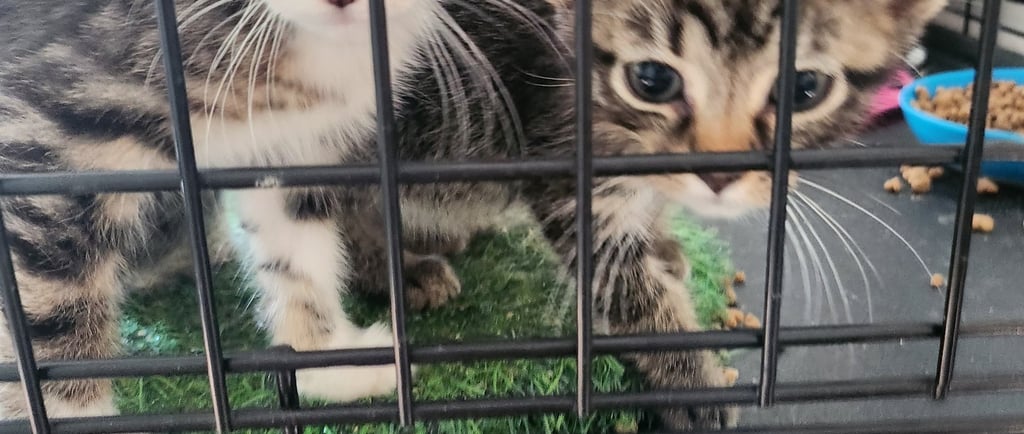How to Choose the Right Cat for Your Lifestyle: The Complete Cat Adoption Guide
Discover how to find your perfect feline companion with this comprehensive guide to cat adoption. Learn to match your lifestyle with the right cat's age, personality, and needs for years of happy companionship.
CAT LIFESPAN
9/6/20257 min read


Bringing a cat into your life is one of the most rewarding decisions you can make, but choosing the perfect feline companion deserves careful consideration. With cats living 12-18 years on average, cat adoption is a long-term commitment that will shape your daily routine, living space, and budget for years to come.
The key to successful pet adoption lies in honest self-assessment and thoughtful matching. The playful kitten that melts your heart at the animal shelter might not be the best fit if you work 12-hour days, just as the low-maintenance senior cat adoption might not satisfy your desire for an active, interactive pet.
This comprehensive cat selection guide will walk you through every aspect of choosing a cat that truly complements your lifestyle, from understanding the differences between life stages to finding reputable sources for cat sanctuary adoption. By the end, you'll have the knowledge and confidence to make a decision that benefits both you and your future feline friend.
Understanding Cat Life Stages: Kitten vs. Adult vs. Senior Cat Adoption
Kittens (0-1 Year): The Adorable Challenge
Pros of Kitten Adoption:
Boundless entertainment: Kittens are naturally curious and playful, providing hours of amusing antics
Adaptability: Young cats adjust more easily to new environments and household rules
Bonding potential: Raising a kitten from a young age often creates an exceptionally strong human-cat bond
Health transparency: You'll have a complete medical history and can establish good cat veterinary care from the start
Training opportunities: Kittens learn litter box training, scratching preferences, and house rules more readily
Cons of Kitten Adoption:
High energy demands: Kittens require multiple play sessions daily and constant mental stimulation
Destructive potential: Expect scratched furniture, knocked-over items, and general mischief during the exploration phase
Intensive care needs: Frequent feeding schedules, litter box monitoring, and veterinary checkups
Sleep disruption: Young cats are often most active during dawn and dusk hours
Unknown personality: A kitten's adult temperament won't fully emerge until 12-18 months
Adult Cats (1-7 Years): The Sweet Spot for Cat Adoption
Pros of Adult Cat Adoption:
Established personality: What you see is generally what you get in terms of temperament and energy level
Reduced maintenance: Adult cats have predictable routines and require less intensive supervision
Immediate companionship: Many adult cats are ready to bond and integrate into your household quickly
Gratitude factor: Adult cats from animal shelters often seem to understand they've been rescued and show remarkable appreciation
Stable energy levels: More predictable activity patterns that align better with human schedules
Cons of Adult Cat Adoption:
Potential behavioral baggage: Previous experiences may have created fears, anxieties, or unwanted habits
Shorter time together: You'll have fewer years with an adult cat compared to a kitten
Adjustment period: Some adult cats need more time to adapt to new homes and family members
Unknown health history: Previous medical issues or genetic predispositions may not be immediately apparent
Senior Cats (8+ Years): The Underrated Gems of Cat Sanctuaries
Pros of Senior Cat Adoption:
Calm companionship: Senior cats typically prefer quiet affection over active play
Low maintenance: Established routines, minimal training needs, and predictable behaviors
Deep appreciation: Older cats often form profound bonds with their adopters
Perfect for quiet homes: Ideal for seniors, busy professionals, or anyone seeking a peaceful house cat
Saving a life: Senior cat adoption is often overlooked at shelters, making adoption truly life-saving
Cons of Senior Cat Adoption:
Higher medical costs: Age-related health issues like arthritis, kidney disease, or dental problems are more common
Shorter lifespan: The emotional reality of having less time together
Potential special needs: May require medications, special diets, or accommodation for mobility issues
Less adaptability: Older cats may struggle more with major household changes
Assessing Your Lifestyle: The Honest Self-Evaluation for Cat Ownership
Living Situation Analysis for Cat Adoption
Apartment Cat Ownership Considerations:
Space limitations: Even small apartments can work for cats, but consider vertical space with cat trees and shelving
Noise restrictions: Some cats are more vocal than others; research breed tendencies if noise is a concern
Landlord policies: Ensure pet-friendly housing policies allow cats and understand any additional deposits or restrictions
Emergency planning: Have a plan for pet care during building emergencies or temporary relocations
House Cat Ownership Advantages:
More territory: Cats appreciate having multiple rooms to explore and claim as their own
Outdoor access options: Houses often provide easier implementation of supervised outdoor time for indoor cats who may have such a need
Noise freedom: Less concern about vocal cats disturbing neighbors
Space for multiple cats: Larger homes can more easily accommodate multi-cat households
Routine and Schedule Evaluation for Cat Care
Work Schedule Impact on Cat Ownership:
Long hours (9+ hours away): Consider adult or senior cat adoption over kittens; ensure adequate cat enrichment
Frequent travel: Cats generally handle routine better than dogs, but still need consistent pet care arrangements
Work-from-home: Any cat can thrive, but be prepared for "helpful" participation in video calls
Irregular schedules: Cats adapt well to varying routines once they understand the household patterns
Family Dynamics and Cat Selection:
Young children: Patient, gentle cats work best; avoid kittens who might scratch during play
Teenagers: Often excellent cat companions who can handle cat feeding and basic care responsibilities
Multi-generational homes: Senior cats often provide comfort to elderly family members
Energy Level and Interaction Preferences in Cat Breeds
High-Energy Household Cat Matches:
Best matches: Kittens, young adult cats, active cat breeds like Bengals or Abyssinians
Commitment required: Multiple daily cat play sessions, puzzle feeders, interactive toys
Benefits: Highly engaging pets that participate actively in family life
Moderate-Energy Household Cat Selection:
Best matches: Most adult cats, many mixed breed cats, moderate-energy purebreds
Commitment required: Daily play sessions, regular interaction, standard cat enrichment
Benefits: Balanced companionship without overwhelming care demands
Low-Energy Household Cat Adoption:
Best matches: Senior cats, naturally calm breeds like Persians or Ragdolls
Commitment required: Gentle daily interaction, comfortable sleeping spaces, routine cat veterinary care
Benefits: Peaceful companionship perfect for relaxation and stress relief
Indoor vs. Outdoor Cat Care: The Safety Debate
Indoor-Only Cats: The Safer Choice
Safety Benefits of Indoor Cat Life:
Eliminated traffic risks: No chance of vehicle-related injuries or death
Disease prevention: Reduced exposure to FIV, FeLV, parasites, and other transmissible conditions
Predator protection: Safety from coyotes, dogs, and other animals that might harm cats
Theft prevention: No risk of cat theft or accidental "adoption" by well-meaning neighbors
Weather protection: Shelter from extreme temperatures, storms, and seasonal hazards
Quality of Life Considerations for Indoor Cats:
Environmental enrichment needs: Indoor cats require more stimulation through toys, climbing structures, and interactive play
Weight management: Indoor cats may need more attention to diet and exercise to prevent cat obesity
Mental stimulation: Puzzle feeders, rotating toys, and window perches become essential for psychological health
Human interaction: Indoor cats often develop stronger bonds with their human families
Supervised Outdoor Access: The Compromise Solution
Effective Methods for Safe Outdoor Cat Access:
Enclosed patios or "catios": Screened outdoor spaces that provide fresh air and environmental stimulation safely
Harness training: Supervised walks that allow exploration under direct control
Secure fencing: Specialized cat-proof fencing systems for yards
Timed outdoor sessions: Supervised yard time during specific hours
Finding Your Perfect Cat: Animal Shelters vs. Cat Rescues / Sanctuaries
Animal Shelters: The Community Resource for Cat Adoption
Advantages of Shelter Cat Adoption:
Cost-effective: Lower cat adoption fees that typically include spaying/neutering and basic veterinary care
Immediate availability: Large selection of cats available for same-day adoption
Life-saving impact: Direct contribution to reducing pet overpopulation
Staff knowledge: Animal shelter workers often provide valuable insights about individual cat personalities
Support services: Many shelters offer post-adoption support and resources
What to Expect from Animal Shelter Adoption:
Varied backgrounds: Cats may be strays, owner surrenders, or transfers from other facilities
Basic medical care: Most shelter cats receive vaccinations, spay/neuter surgery, and health screenings
Behavioral assessments: Many shelters evaluate cats for temperament and compatibility with children or other pets
Adoption processes: Expect applications, interviews, and sometimes waiting periods
Cat Sanctuary Organizations: The Specialized Approach
Unique Benefits of Cat Sanctuary Adoption:
Foster-based insights: Cats living in foster homes come with detailed personality profiles
Specialized matching: Many cat rescues and sanctuaries excel at matching cats with appropriate families
Breed-specific options: Some rescues and sanctuaries focus on particular cat breeds or types of cats
Comprehensive care: Foster-based cats often receive more individualized medical and behavioral attention
Ongoing support: Cat sanctuary organizations frequently provide lifetime support for adopted cats
Cat Sanctuary Considerations:
More selective process: Rescues and sanctuaries often have more detailed application and screening processes
Potential waiting lists: Popular rescues and sanctuaries may have waiting periods for specific types of cats
Higher fees: Cat sanctuary adoption fees may be higher due to comprehensive care provided
Geographic limitations: Some rescues and sanctuaries serve specific regions or have limited service areas
Essential Questions for Cat Shelters and Rescues / Sanctuaries
Health and Medical History Questions
Fundamental Cat Health Questions:
"What medical care has this cat received while in your care?"
"Are there any known cat health issues or concerns I should be aware of?"
"What cat vaccinations has this cat received, and when are boosters due?"
"Has this cat been spayed or neutered? If not, when can this be scheduled?"
"Are there any medications this cat is currently taking?"
Cat Personality and Compatibility Assessment
Temperament Assessment Questions:
"How would you describe this cat's personality and energy level?"
"How does this cat interact with new people?"
"What are this cat's favorite activities or types of cat play?"
"How affectionate is this cat? Do they enjoy being held or petted?"
Social Dynamics Questions:
"How does this cat get along with other cats?"
"Has this cat been around cats and dogs? How did they react?"
"How does this cat behave around children and cats of different ages?"
"Does this cat prefer to be the only pet or do they enjoy company?"
Making the Final Cat Adoption Decision
Choosing the right cat is ultimately about finding the best match between your lifestyle and a cat's needs. Take time to honestly assess your living situation, daily routine, and long-term cat ownership commitment ability. Remember that every cat, regardless of age or background, deserves a loving home where they can thrive.
The perfect cat adoption for you might not be the one that first catches your eye. Instead, focus on compatibility, realistic expectations, and your ability to provide consistent cat care for 12-18 years. Whether you choose a playful kitten, a mature adult, or a gentle senior cat, the right match will bring years of joy, companionship, and mutual enrichment to both your lives.
Consider visiting potential cats multiple times if possible, ask plenty of questions, and trust your instincts about compatibility. The time invested in careful cat selection will pay dividends in the form of a harmonious, long-lasting relationship with your new feline family member.
Remember that cat adoption is not just about what they can add to your life, but what you can provide for theirs. Choose with both your heart and your head, and you'll find yourself with a companion who enriches your daily life for years to come.
Key Takeaways for Successful Cat Adoption:
Research cat breeds and life stages to find your best match
Visit local animal shelters, cat rescues and sanctuaries
Ask detailed questions about cat health, personality, and care needs
Consider your living situation and cat care capabilities honestly
Choose indoor cat safety over outdoor risks when possible
Invest in proper cat supplies and veterinary care from day one
Be patient during the cat adjustment period in your new home
Contact us at:
Bre@SpecialLittleWhiskersKittenRescue.com
(217)386-1746
Special Little Whiskers Sanctuary is sustained through affiliate commissions. When you shop through our links, you're directly supporting the animals in our care. Thank you!
© 2025. All rights reserved.
